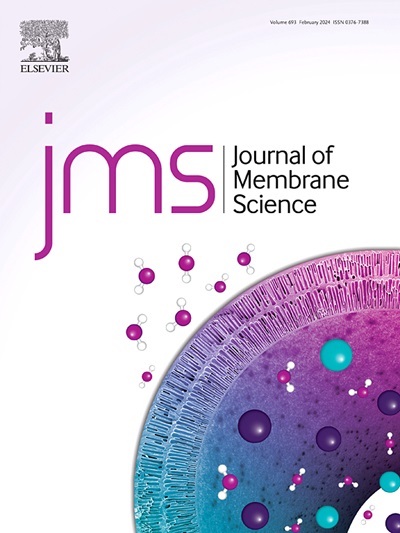定制l-精氨酸修饰聚哌嗪酰胺纳滤膜,增强透水性,高效分离Li+/Mg2+
IF 8.4
1区 工程技术
Q1 ENGINEERING, CHEMICAL
引用次数: 0
摘要
近年来,利用薄膜复合(TFC)纳滤(NF)膜从水资源中回收锂的研究日益受到关注。本研究通过哌嗪(PIP)和三聚甲基氯(TMC)之间的界面聚合(IP)制备了聚哌嗪-酰胺(piperazine-amide)纳滤膜,以有效分离Li+和Mg2+。然而,在渗透率和Li+/Mg2+选择性之间的权衡是一个挑战,需要额外的表面改性来优化性能。用ARG胺基亲水性单体对聚pip -酰胺膜表面进行修饰,然后与戊二醛(GLA)交联。ARG的胺基有望与TMC的未反应的酰氯基相互作用,增加表面正电荷,从而提高Li+/Mg2+的选择性。在含有2000 ppm盐(Li+/Mg2+ 1:20)的溶液中,经ARG和GLA (A2-G0.3)修饰的膜对Li+/Mg2+的选择性为17.11,而未经修饰的膜对Li+/Mg2+的选择性为5.14。值得注意的是,A2-G0.3膜的Li+去除率为- 45.4,Mg2+去除率为91.5%,在70 psi下的水通量为47.0 Lm−2h−1。在总盐浓度超过21,000 ppm的模拟盐水中进行测试时,该膜的Li+截留率为9.5%,Mg2+截留率为90.1%,低压为70 psi时的水通量为18.6 Lm−2h−1。在200小时的模拟进料过滤中,膜保持了一致的性能,证明了其长期稳定性。此外,通过在其表面接枝ARG-GLA层,大大提高了膜的防污性能。这些发现强调了改性膜在高盐度环境中有效回收锂的潜力。本文章由计算机程序翻译,如有差异,请以英文原文为准。

Tailored l-Arginine modified Poly(piperazine-amide) nanofiltration membrane with enhanced water permeability for efficient Li+/Mg2+ separation
In recent years, there has been a growing focus on lithium recovery from water resources using thin-film composite (TFC) nanofiltration (NF) membranes. In this study, a poly(piperazine-amide) NF membrane was fabricated via interfacial polymerization (IP) between piperazine (PIP) and trimesoyl chloride (TMC) to effectively separate Li+ from Mg2+. However, the trade-off between water permeability and Li+/Mg2+ selectivity presented a challenge, requiring additional surface modification to optimize performance. The surface of the poly(PIP-amide) membrane was modified with ARG amine-based hydrophilic monomer, followed by crosslinking with glutaraldehyde (GLA). The amine groups of ARG are expected to interact with the unreacted acyl chloride groups of TMC, increasing the positive surface charge and thereby improving Li+/Mg2+ selectivity. The membrane modified with ARG and GLA (A2-G0.3) exhibited a significantly improved Li+/Mg2+ selectivity of 17.11, compared to 5.14 for the unmodified membrane when tested in a solution containing 2000 ppm of salts (Li+/Mg2+ of 1:20). Notably, the A2-G0.3 membrane demonstrated a Li+ rejection of −45.4 and Mg2+ rejection of 91.5 %, with a water flux of 47.0 Lm−2h−1 at 70 psi. When tested with a simulated brine with a total salt concentration exceeding 21,000 ppm, the membrane exhibited a Li+ rejection of 9.5 % and Mg2+ rejection of 90.1 %, along with a water flux of 18.6 Lm−2h−1 at low pressure of 70 psi. The membrane maintained consistent performance over 200 h of simulated feed filtration, demonstrating its long-term stability. Moreover, the antifouling performance of the membrane was greatly improved by grafting the ARG-GLA layer onto its surface. These findings highlight the modified membrane's potential for effective lithium recovery in high-salinity environments.
求助全文
通过发布文献求助,成功后即可免费获取论文全文。
去求助
来源期刊

Journal of Membrane Science
工程技术-高分子科学
CiteScore
17.10
自引率
17.90%
发文量
1031
审稿时长
2.5 months
期刊介绍:
The Journal of Membrane Science is a publication that focuses on membrane systems and is aimed at academic and industrial chemists, chemical engineers, materials scientists, and membranologists. It publishes original research and reviews on various aspects of membrane transport, membrane formation/structure, fouling, module/process design, and processes/applications. The journal primarily focuses on the structure, function, and performance of non-biological membranes but also includes papers that relate to biological membranes. The Journal of Membrane Science publishes Full Text Papers, State-of-the-Art Reviews, Letters to the Editor, and Perspectives.
 求助内容:
求助内容: 应助结果提醒方式:
应助结果提醒方式:


